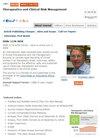Assessment of Pharmacokinetic Effects of Herbal Medicines on Escitalopram
IF 2.8
3区 医学
Q1 Pharmacology, Toxicology and Pharmaceutics
引用次数: 0
Abstract
Purpose: Herbal medicines are occasionally used in combination with conventional antidepressants to mitigate various depression-associated symptoms. However, there is limited information on herb–antidepressant interactions. In this study, we investigated the pharmacokinetic (PK) effects of four herbal medicines (Gami-soyosan, Banhasasim-tang, Ojeok-san, and Bojungikgi-tang) on escitalopram, a commonly used antidepressant.Patients and Methods: In this open-label, fixed-sequence, three-period, crossover study, 18 participants were enrolled and divided into two groups. Each group received a 10 mg oral dose of escitalopram in period 1. Participants took escitalopram once daily and their assigned herbal medicines thrice a day for 7 d in periods 2 (group 1: Gami-soyosan, group 2: Ojeok-san) and 3 (group 1: Banhasasim-tang; group 2: Bojungikgi-tang). The primary endpoints were Cmax,ss and AUCtau,ss of escitalopram. Cmax,ss and AUCtau,ss in period 1 were obtained using nonparametric superposition from single-dose data. The PK endpoints were classified according to the CYP2C19 phenotype.
Results: Of 18 participants, 16 completed the study. Systemic exposure to escitalopram resulted in a minor increase in the presence of each herbal medicine. The geometric mean ratios (GMRs, combination with herbal medicines/escitalopram monotherapy) and their 90% confidence intervals (CIs) for Cmax,ss and AUCtau,ss were as follows: Gamisoyosan– 1.1454 (0.9201, 1.4258) and 1.0749 (0.8084, 1.4291), Banhasasim-tang– 1.0470 (0.7779, 1.4092) and 1.0465 (0.7035, 1.5568), Ojeok-san– 1.1204 (0.8744, 1.4357) and 1.1267 (0.8466, 1.4996), and Bojungikgi-tang– 1.1264 (0.8594, 1.4762) and 1.1400 (0.8515, 1.5261), respectively. Furthermore, no significant differences in the GMRs of Cmax,ss and AUCtau,ss were observed across different CYP2C19 phenotypes in any of the groups.
Conclusion: The co-administration of escitalopram with Gami-soyosan, Banhasasim-tang, Ojeok-san, or Bojungikgi-tang did not exert significant PK effects on escitalopram. These findings provide valuable insights into the safe use of herbal medicines along with escitalopram.
Keywords: CYP2C19 phenotype, herb–drug interaction, antidepressant, geometric mean ratio
评估草药对艾司西酞普兰的药代动力学影响
目的:中草药偶尔会与传统抗抑郁药联合使用,以减轻各种抑郁症相关症状。然而,有关草药与抗抑郁药之间相互作用的信息却很有限。在这项研究中,我们调查了四种草药(Gami-soyosan、Banhasasim-tang、Ojeok-san 和 Bojungikgi-tang)对常用抗抑郁药艾司西酞普兰的药代动力学(PK)影响:在这项开放标签、固定顺序、三期交叉研究中,18 名参与者被分为两组。每组在第一阶段口服 10 毫克的艾司西酞普兰。在第 2 期(第 1 组:Gami-soyosan;第 2 组:Ojeok-san)和第 3 期(第 1 组:Banhasasim-tang;第 2 组:Bojungikgi-tang),参与者每天服用一次艾司西酞普兰,同时每天服用三次指定的中药,共服用 7 天。主要终点是艾司西酞普兰的 Cmax,ss 和 AUCtau,ss。第一阶段的Cmax,ss和AUCtau,ss是通过单剂量数据的非参数叠加得到的。PK终点根据CYP2C19表型进行分类:18名参与者中有16人完成了研究。全身暴露于艾司西酞普兰会导致每种中药的含量略有增加。Cmax,ss和AUCtau,ss的几何平均比(GMRs,与中药联合/艾司西酞普兰单药治疗)及其90%置信区间(CIs)如下:Gamisoyosan- 1.1454 (0.9201, 1.4258) 和 1.0749 (0.8084, 1.4291),Banhasasim-tang- 1.0470 (0.7779, 1.4092) 和 1.0465 (0.7035, 1.5568),Ojeok-san- 1.1204(0.8744,1.4357)和 1.1267(0.8466,1.4996),以及 Bojungikgi-tang- 1.1264(0.8594,1.4762)和 1.1400(0.8515,1.5261)。此外,各组中不同 CYP2C19 表型的 Cmax,ss 和 AUCtau,ss 的 GMR 均无明显差异:结论:艾司西酞普兰与Gami-soyosan、Banhasasim-tang、Ojeok-san或Bojungikgi-tang联合用药不会对艾司西酞普兰产生显著的PK影响。这些发现为中药与艾司西酞普兰的安全使用提供了有价值的见解:CYP2C19表型 草药-药物相互作用 抗抑郁药 几何平均比值
本文章由计算机程序翻译,如有差异,请以英文原文为准。
求助全文
约1分钟内获得全文
求助全文
来源期刊

Therapeutics and Clinical Risk Management
HEALTH CARE SCIENCES & SERVICES-
CiteScore
5.30
自引率
3.60%
发文量
139
审稿时长
16 weeks
期刊介绍:
Therapeutics and Clinical Risk Management is an international, peer-reviewed journal of clinical therapeutics and risk management, focusing on concise rapid reporting of clinical studies in all therapeutic areas, outcomes, safety, and programs for the effective, safe, and sustained use of medicines, therapeutic and surgical interventions in all clinical areas.
The journal welcomes submissions covering original research, clinical and epidemiological studies, reviews, guidelines, expert opinion and commentary. The journal will consider case reports but only if they make a valuable and original contribution to the literature.
As of 18th March 2019, Therapeutics and Clinical Risk Management will no longer consider meta-analyses for publication.
The journal does not accept study protocols, animal-based or cell line-based studies.
 求助内容:
求助内容: 应助结果提醒方式:
应助结果提醒方式:


